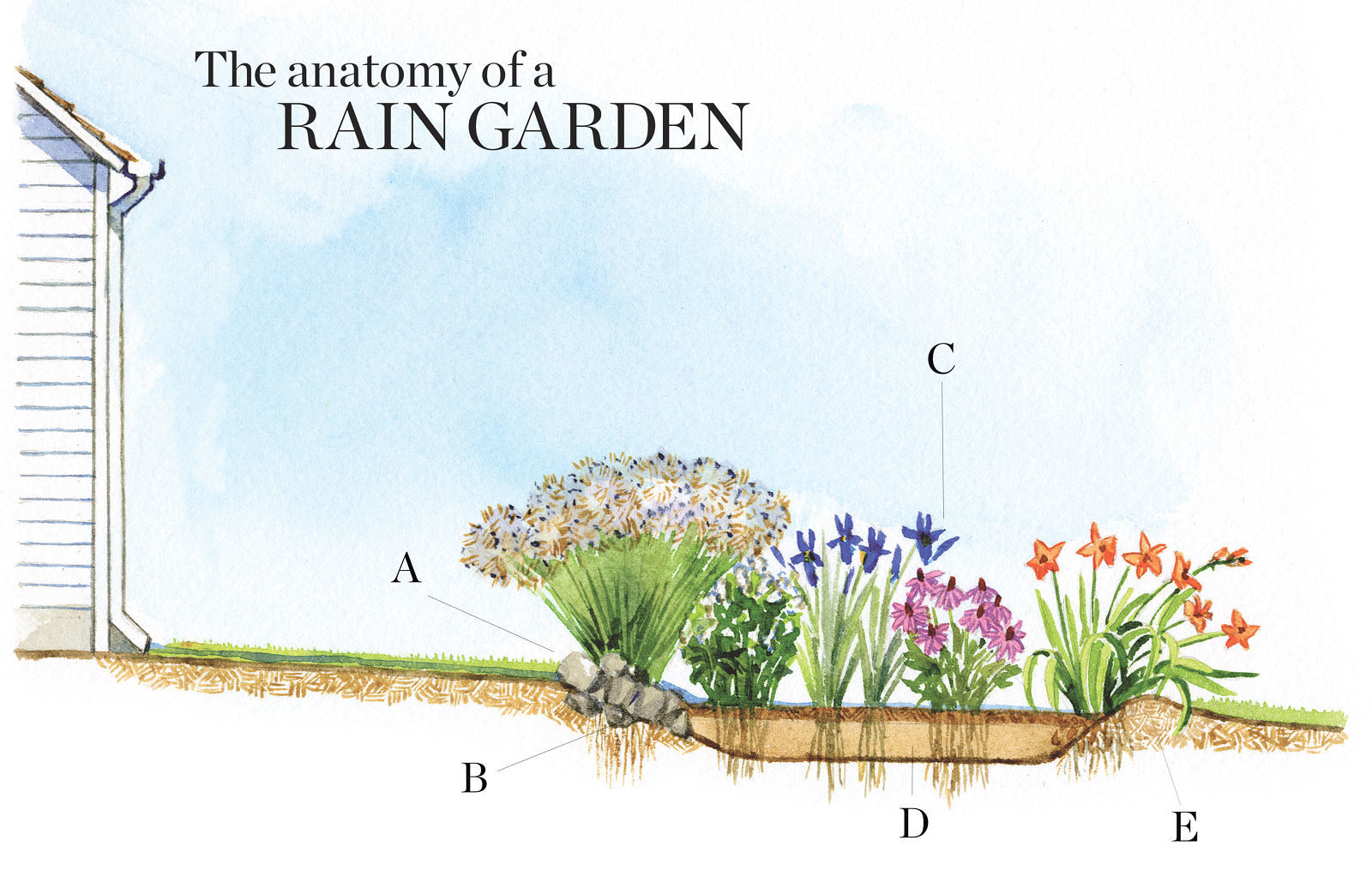
The term “rain garden” is a bit of a misnomer. Sounding like it is some kind of a water-logged bog, a rain garden, in fact, is a slightly sunken garden designed to capture stormwater runoff. Rain gardens can alleviate erosion on your property while trapping fertilizers, pesticides, and organic pollutants (like grass clippings) before they wash down storm drains; from there, they can enter creeks and streams and cause algal blooms, reducing available oxygen for fish and other animals. Rain gardens to the rescue! Water is trapped, and pollutants are removed by plant roots and the garden’s filter bed. Once caught in the filter bed, earthworms and microorganisms ingest and neutralize these contaminants.
Learn more: Plants for a Rain Garden
A rain garden can be as simple or elaborate as you like, and it can be installed in less than a day. Think of this: If everyone with a yard planted a rain garden, polluted runoff coming from residential neighborhoods would be substantially reduced.
Select your site carefully
If you’ve noticed a part of the yard where rains cause erosion or pooling, you can probably create a rain garden. Find out where the garden will catch the maximal runoff by going outside in the rain and watching how and where water flows. Start by looking at how water comes off your roof or other hard surfaces and moves across your property. Placed in the runoff’s path, a rain garden can stop erosion or catch water slightly uphill from where it pools. But don’t plant a garden in this pool of water—this isn’t a bog planting, remember.

To deal with runoff that accumulates as it runs down a slope or from neighboring properties, you’ll have to work with what you see. Consider the amount of water moving onto your property and how it enters. Water enters my yard, for example, from a neighbor’s property. I looked at the square footage of their roof and which of their downspouts dumps runoff toward my yard, then designed my rain garden accordingly. Remember that you will never be able to catch all the runoff, but collecting any is better than none.
Site your rain garden at least 10 feet from your home’s foundation to avoid seepage. If you have a well or septic system, check local building regulations to see how far your rain garden should be from these utilities. When you think you’ve found the spot, conduct an infiltration test. Dig a 4-inch-diameter and 1-foot-deep hole where you’d like to build, and fill it with water. If it drains in less than 48 hours, it a suitable spot. If not, then you need another site.
You don’t need special equipment or professional hires to start catching runoff, but rain gardens need the same care as other gardens: watering when dry, routine pruning and deadheading, and topdressing with mulch every year to provide nutrients and to suppress weeds. So with all this potential for a positive impact, why are you still reading? Get outside, and start analyzing where you can build your very own gorgeous rain garden!
A – Rockery
If runoff flows across your site with speed and force, add a row of stones or other heavy material that will slow the water like a speed bump. Use something that relates to the overall design of your garden.
B – Depression
A 3- to 6-inch-deep depression with sloped sides, like that of a pie dish, catches and holds water above the filter bed. A 6-inch ponding depth—or gap between the natural soil grade and the top of the filter bed—holds the most water in the smallest space. Heavy clay soil can be difficult to amend deeply, so a wider and shallower 3-inch depth might be a better option. Choose a depth according to your needs.
C – Plants
Plants suitable for rain gardens are those that thrive in periods of short-term flooding (less than two days) as well as in periods of drought, both of which are common in North American weather patterns. Avoid plants that colonize, as they will run rampant in the filter bed, and include woody plants to maximize the garden’s performance year-round. See plants for a rain garden.
D – Filter bed
The filter bed should be at least 6 to 12 inches deep. Its soil must contain coarse particles that let water in and finer particles that hold water for plant use; the addition of compost secures both. Compost creates pore spaces in slow-draining clay soils for improved water infiltration; in sandy soils, it slows infiltration, so plants get a chance to take up water before it wicks away. Compost, furthermore, provides nutrients necessary for healthy plant and microbial growth. The addition of 25 percent compost usually is enough to get the job done.
E – Berm
If your rain garden is on a slope, use some soil from the initial dig to build a berm on the rain garden’s lower side. A berm holds water that might otherwise flow down the slope and out of the planting, thus defeating the garden’s purpose.
|
Helpful Tip – Make a call before you dig! |
|
Call your local utilities locator (811 is the number for the national one-call center) to request a crew to mark where underground utility lines are buried. This is a free service. |






















Comments
No amount of decors will compensate for a rain garden that looks weathered and untended. Always ensure cleanliness around your rain garden by sweeping away fallen leaves and pulling out weeds growing in the soil and around the berm. For better upkeep, choose plants that are native to your region, as they are more likely to flourish with minimal care.
https://www.usehometips.com/decorate-rain-garden/
Log in or create an account to post a comment.
Sign up Log in